Songpyeon (Korean Chuseok Rice Cake)
Learn how to make Songpyeon with this easy recipe! These Korean half-moon shape rice cakes are essential for your Chuseok celebration. Elevate the festive spirit by incorporating natural food powders for colorful Songpyeon. Explore a range of delightful sweet fillings and learn traditional steaming techniques for a perfect batch!
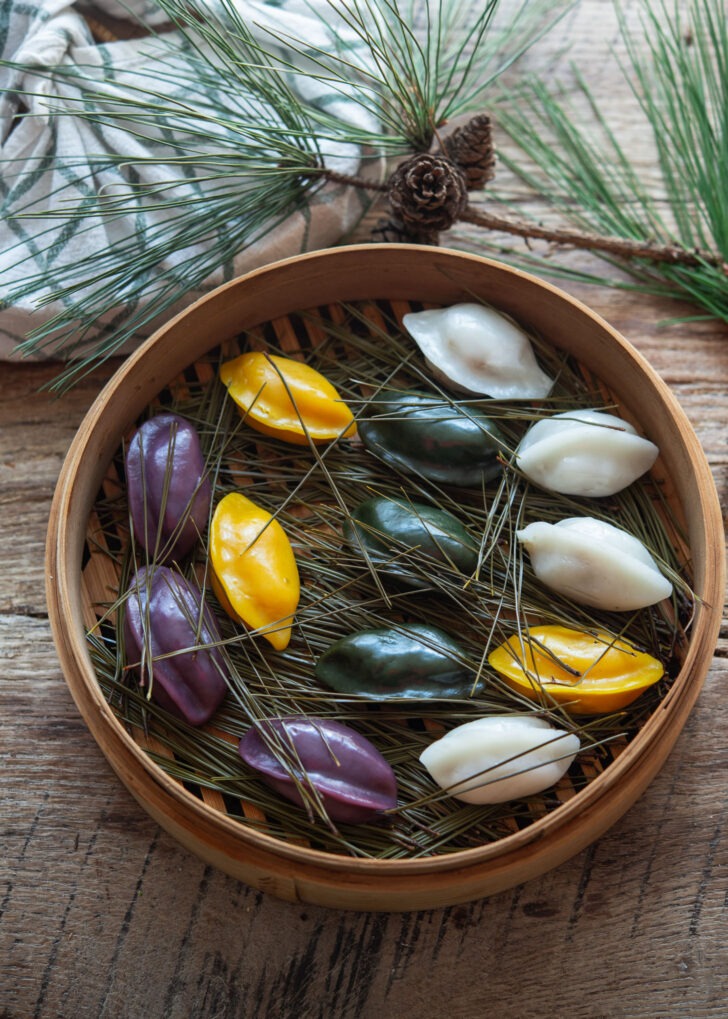
Songpyeon and Chuseok
Chuseok (추석), also known as Hangawi, is a cherished Korean Thanksgiving holiday together with the Lunar New Year (Seollal, 설날) in South Korea. It falls on the 15th day of the 8th lunar month – the same day many Asian countries celebrate a Mid-Autumn Festival.
It’s a time when families and relatives come together to give thanks for the year’s harvest and enjoy home-cooked dishes and enjoy traditional games creating lasting memories. At the heart of this celebration is Songpyeon (송편), traditional Korean rice cake.
These half-moon shape rice cake (tteok, 떡) is a must-have Chuseok delicacy. Made from non-glutinous, short grain rice flour and stuffed with sweet filling such as sweetened sesame seeds and traditionally steamed on a bed of pine needles. The name songpyeon stems from the use of pine needles, because “song” in “songpyeon” means pine tree.
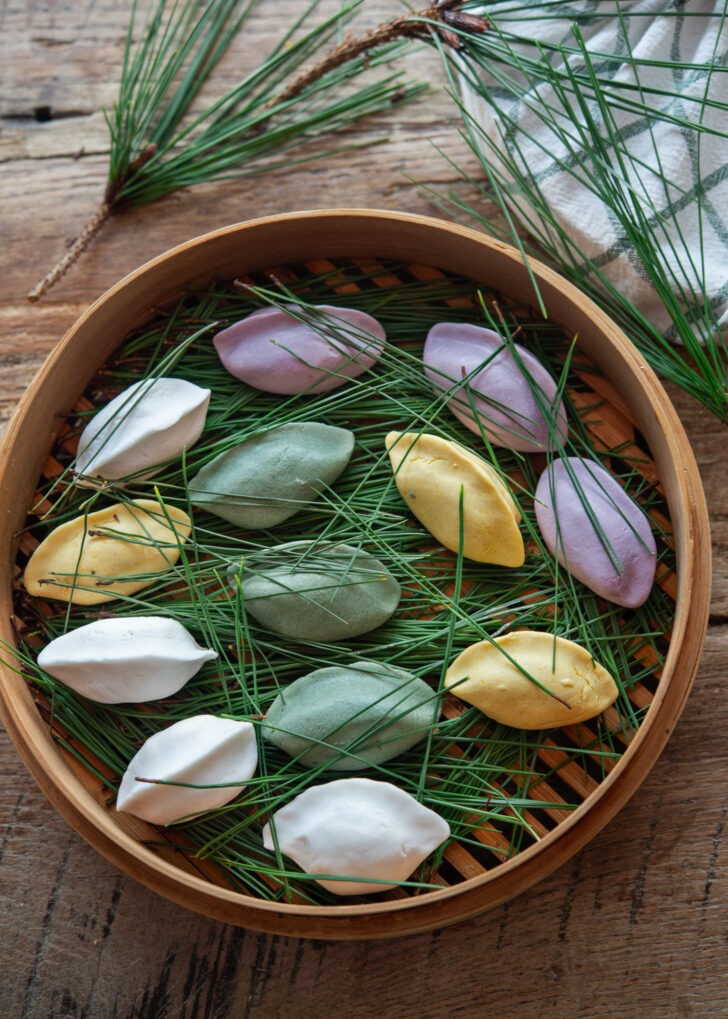
What type of rice flour to use for Songpyeon Dough?
Songpyeon is made with short-grain rice flour (쌀가루), distinct from glutinous rice (sweet rice) flour (찹쌀가루). For the use of glutinous rice flour, please refer to my Injeolmi recipe. Traditionally, Korean home cooks soaked short grain rice overnight and then ground it into a fine powder at a gristmill.
However, not everyone has access to such facilities. The good news is that you can easily find bags of frozen wet rice powder for making rice cakes in the freezer section of Korean grocery stores.
Alternatively, you can make rice flour at home by soaking short grain rice overnight, draining it for several hours, and then finely grinding it using a powerful blender, spice grinder, or food processor. Please note that the resulting rice flour or batter may still have a slightly grainy texture, rather than being as soft as traditionally ground flour.
Another option is to use dry short grain rice flour, which is derived from dry rice grains without soaking. If you choose this type, you’ll need to use a larger amount of water and allow the dough to soak for a longer period to ensure it absorbs enough moisture to create a moist dough for your Songpyeon. See my recipe expert tips below.
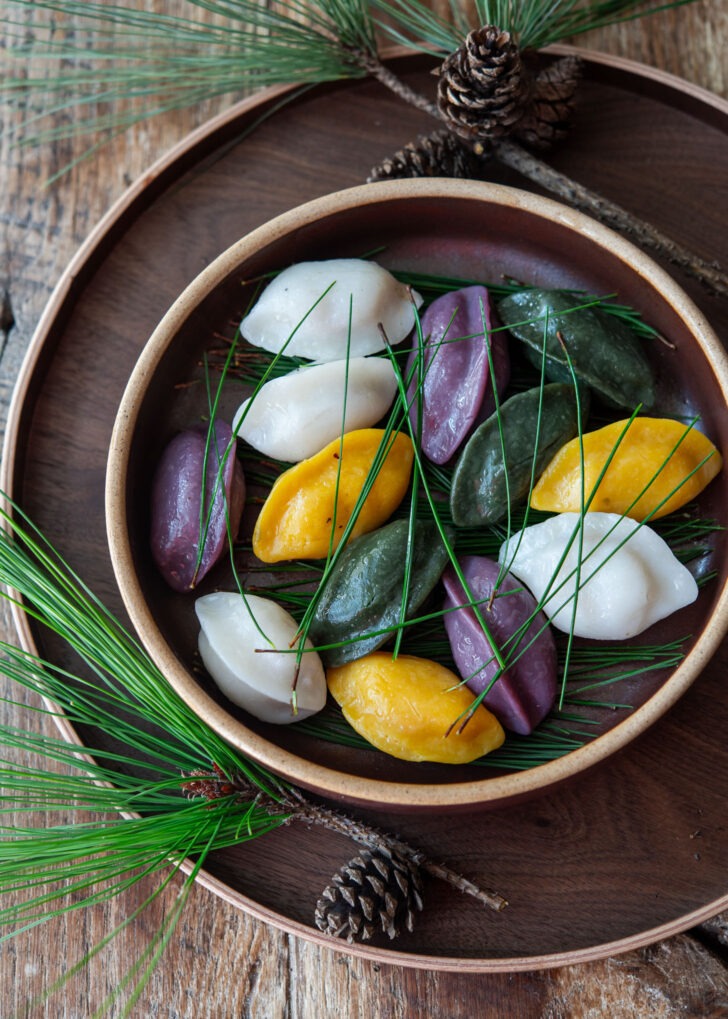
Natural Flavors and Colors
Songpyeon dough is traditionally flavored and colored using natural ingredients. The most commonly used for coloring the rice cake dough are in powdered form, including mugwort powder, pumpkin powder, and purple sweet potato powder.
If you don’t have these specific powders on hand, you can explore alternative natural food coloring options. Try using dried fruit powders, pureed vegetables or fruit juices like mashed kabocha or spinach juice, as well as pomegranate or raspberry juice.
However, it’s essential to adjust the recipe’s water quantity when incorporating juice to ensure the dough maintains the desired consistency.
Pine needles
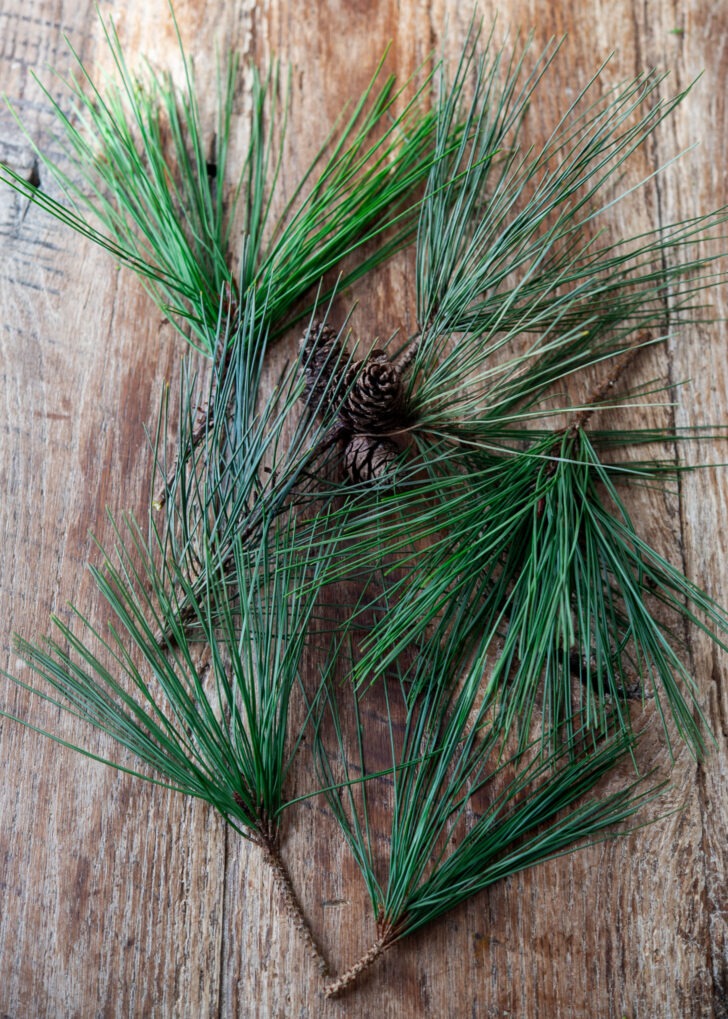
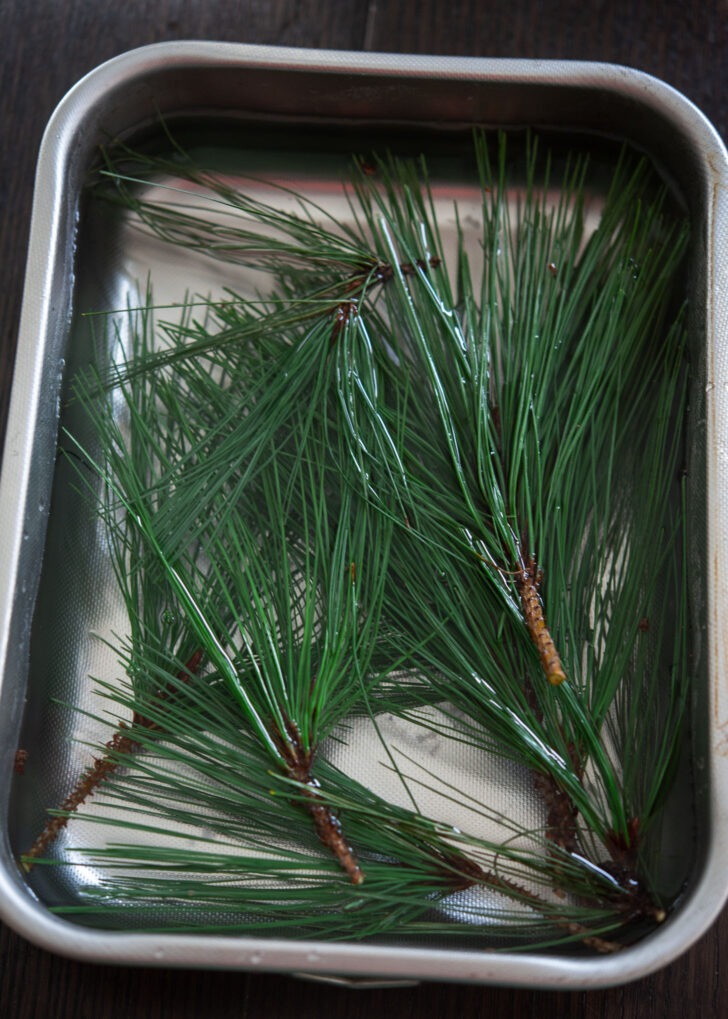
One of the fascinating aspects of Songpyeon preparation is the traditional method of steaming, which involves using pine needles. This practice has historical and practical significance.
Historically, during the harvest season, fresh pine needles were readily available, adding an earthy aroma and flavor to the rice cakes, connecting them to the spirit of the harvest. Moreover, pine needles’ natural antimicrobial properties helped preserve the rice cakes, crucial in times when refrigeration was unavailable.
I gathered pine needles from our neighborhood trail, so I encourage you to explore your local area to find some as well. However, if pine needles aren’t readily available, they are not essential, and you can use a liner for steaming instead.
When using wild pine needles, remember to soak them in water for 10 minutes before adding them to the steamer to remove any dust or debris.
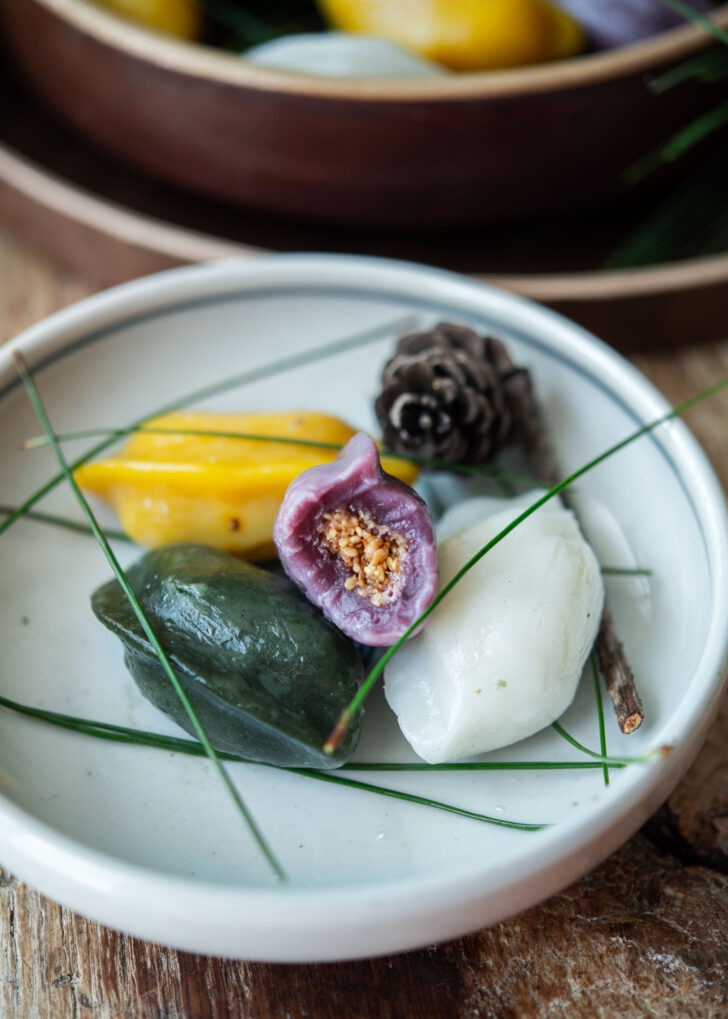
Sweet Fillings
Part of the joy of savoring these half-moon rice cakes is the delightful surprise each one holds within. While the most common filling is a delectable mixture of sweetened sesame seeds, sugar, and a touch of honey, the world of Songpyeon fillings offers endless possibilities.
Explore variations such as black sesame seeds, mung beans, black soybeans, red beans, peanuts, jujubes, walnuts, and more. Consider experimenting with multiple filling options to enhance the enjoyment of your rice cakes. Each bite brings a delightful revelation of flavors and textures.
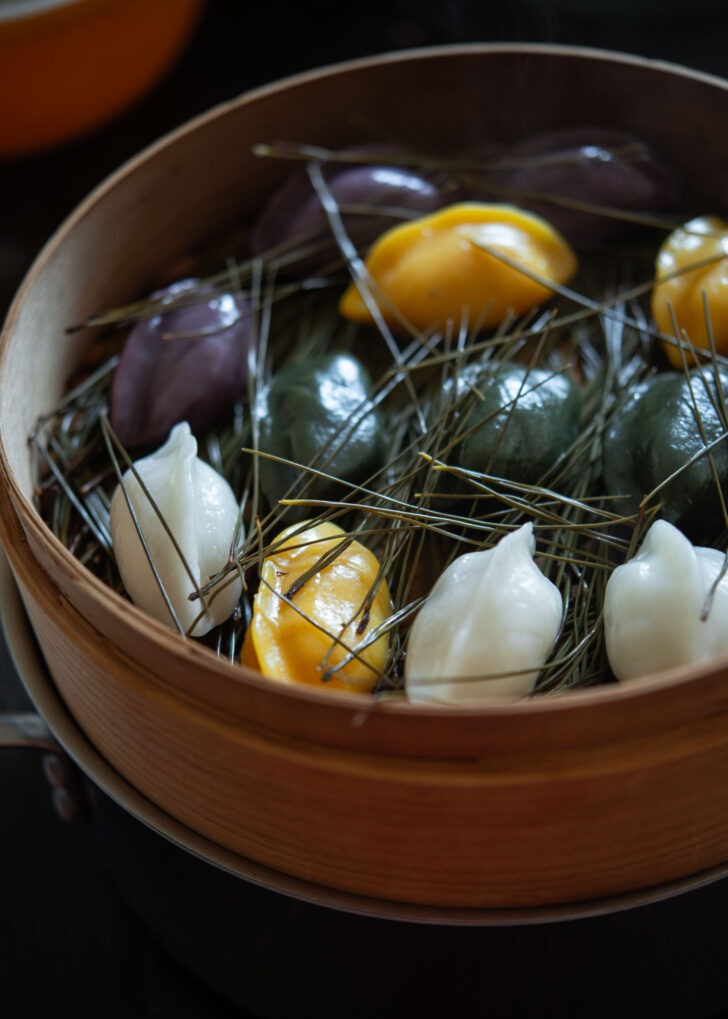
Expert Tips
- Use hot water for creating the dough. The amount of water is a guideline and may vary depending on the brand of flour and humidity. The best way to determine the right consistency is by feeling the texture as you knead the dough.
- A helpful description of the correct consistency is that when you press the dough with a finger, it should feel similar to the texture of your earlobe.)
- After adding and sealing the filling, be sure to gently squeeze the dough to remove any trapped air, which you might hear as a popping or hissing sound.
- Trapped air inside the dough can cause the rice cake to burst while steaming.
- When steaming, place a cotton kitchen towel under the steamer lid to catch any water drips, preventing your cake from becoming mushy.
- Immerse the hot rice cake in a bowl of ice-cold water immediately after steaming. This will rapidly shock and cool down the cake, resulting in a smoother surface.
- If you’re using dry rice flour instead of wet rice flour, follow these steps:
- Combine the flour with salt.
- Add 3 tablespoons of water and rub the rice flour between your palms to evenly distribute the moisture.
- Pass it through a medium sieve to sift.Cover the mixture with plastic wrap and allow it to rest in the fridge for a few hours or overnight. From then on, follow the recipe preparation.
Ingredients Needed
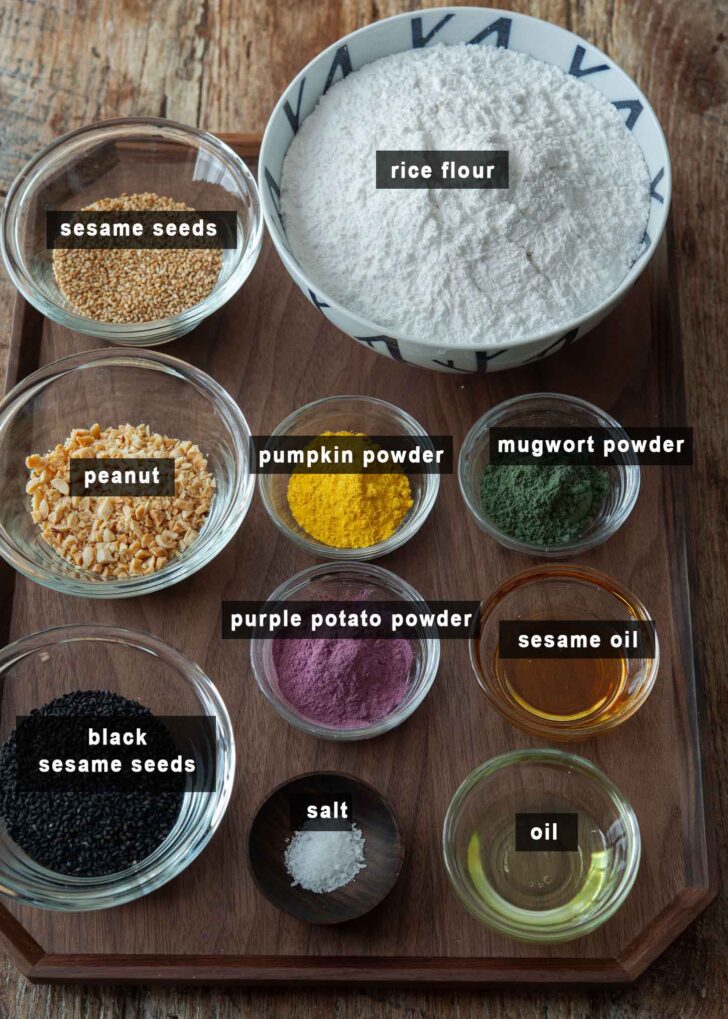
- Rice flour: use frozen wet rice flour (if using plain dry rice flour (short grain), see the recipe tips above for the instructions.
- Salt: to season the cake
- Water: make sure to use hot water. It aborbs into the rice flour faster creating softer and more pliable texture
- Coloring powder: mugwort powder, pumpkin powder, purple sweet potato power. Use other types of natural powder for your own creation.
- Sugar and honey: to sweetened the filling
- Sesame oil and vegetable oil: If using sesame oil alone can darken the rice cake. Mixing both oils can add the lust to the cake without darkening and prevent them from sticking each other.
How to make Songpyeon Dough
Preparing Classic Rice Cake Dough
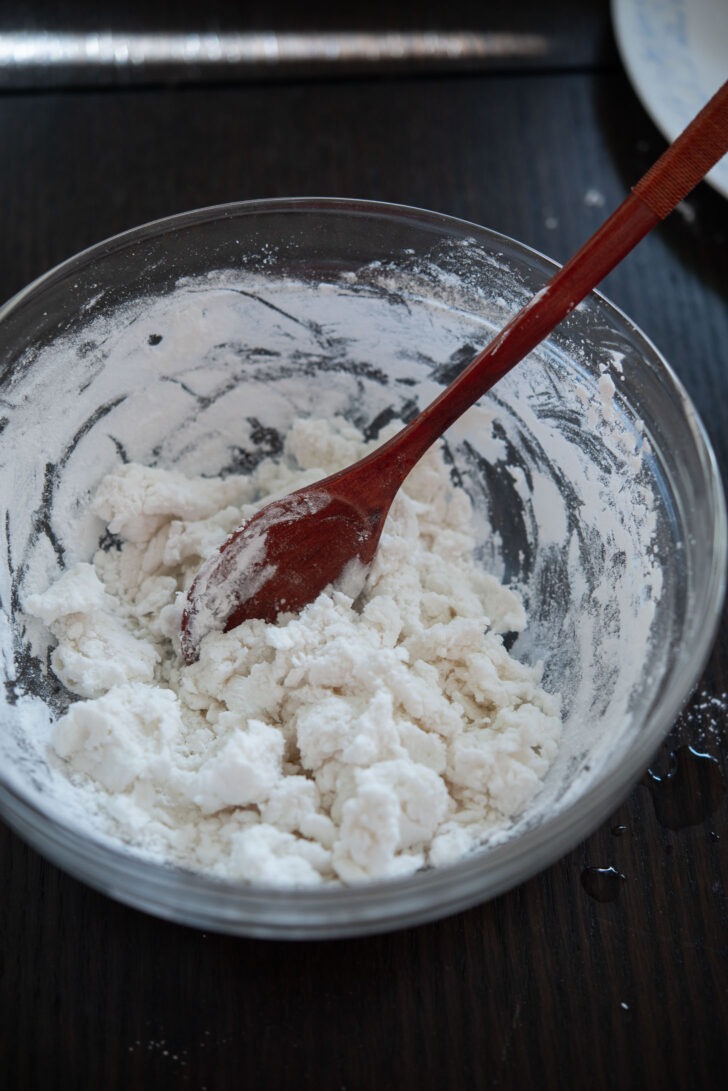
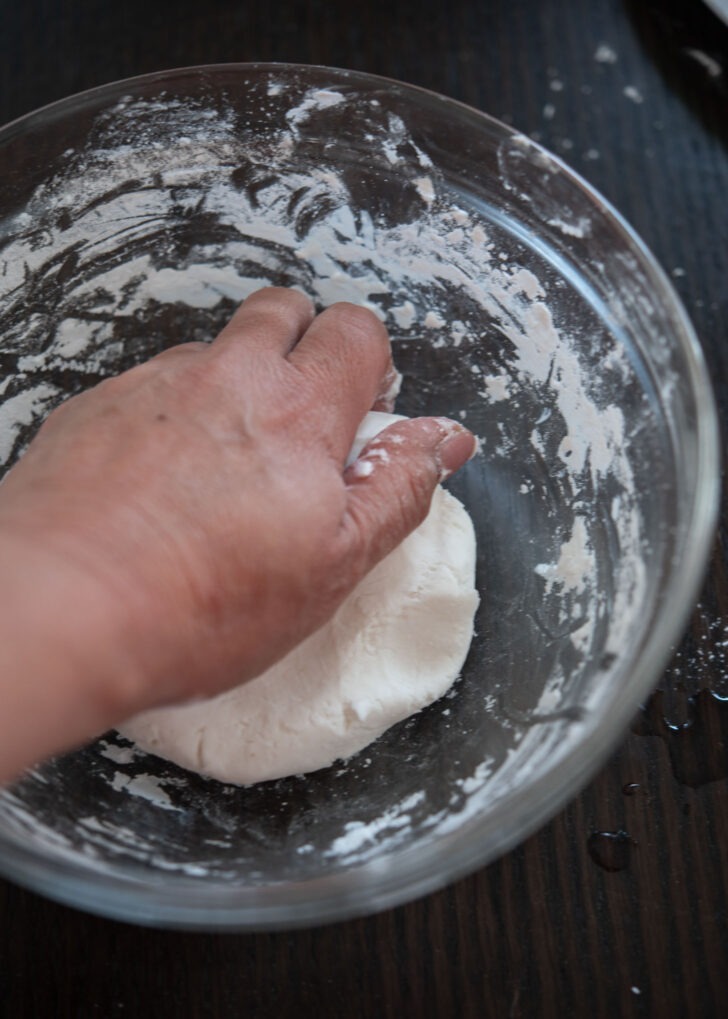
- In a medium bowl, combine rice flour and a pinch of salt. Begin by adding 2-3 tablespoons of water and stir with a spoon. If necessary, add a teaspoon or two more of water to achieve the desired consistency.
- Knead the dough by pressing and stretching it with the heel of your hand. Remember to fold and rotate the dough during this process. Continue kneading for 4 to 5 minutes.
To adjust the dough’s consistency:
- If the dough becomes too wet and sticks to your hands or the bowl, add more rice powder in 1 teaspoon gradations.
- If the dough feels too dry and breaks easily, it needs more moisture. Gradually add more boiling hot water in 1 teaspoon gradations.
- The dough should reach a texture where, when pressed with a finger, it feels similar to your earlobe.
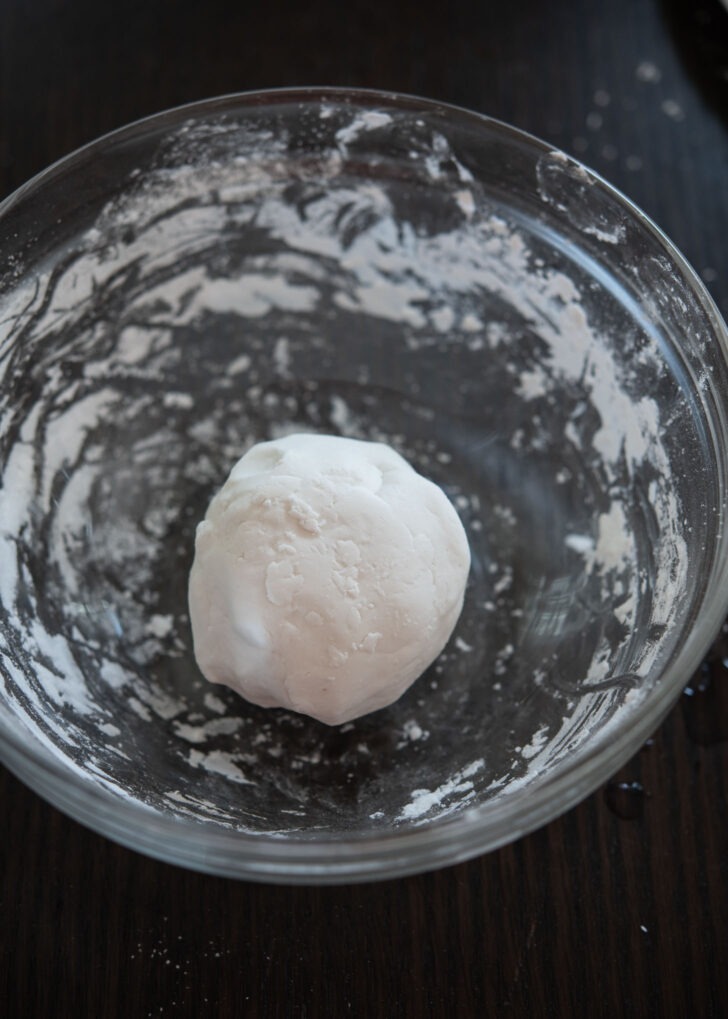
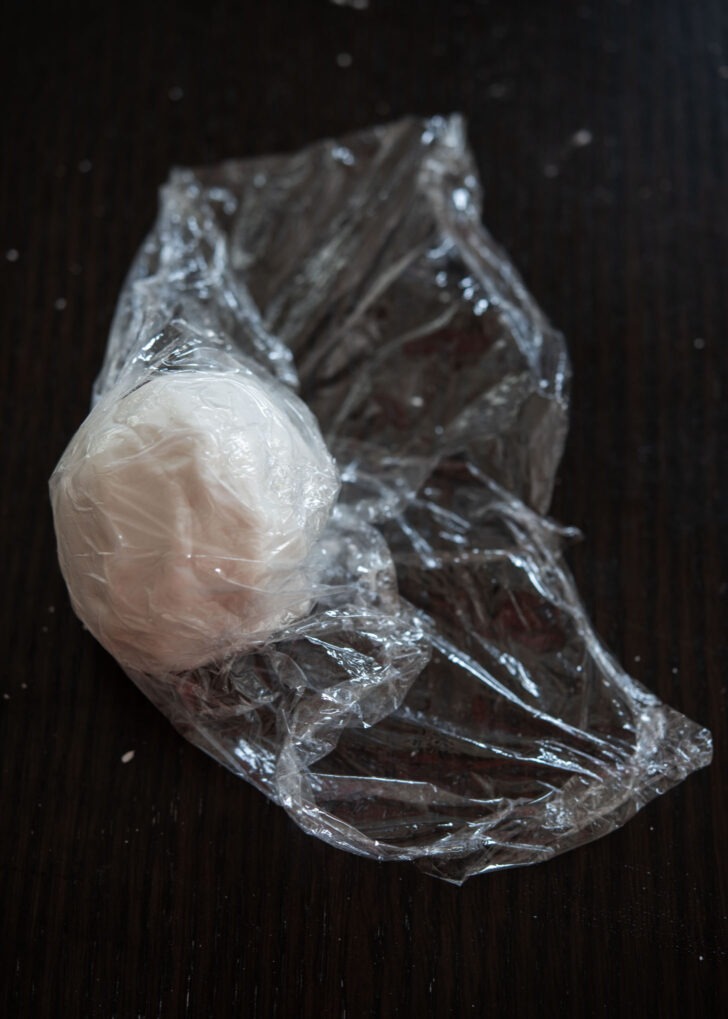
- Cover the dough with plastic wrap and allow it to rest for 20 to 30 minutes. This resting period helps relax the dough for better handling.
For Colored Dough
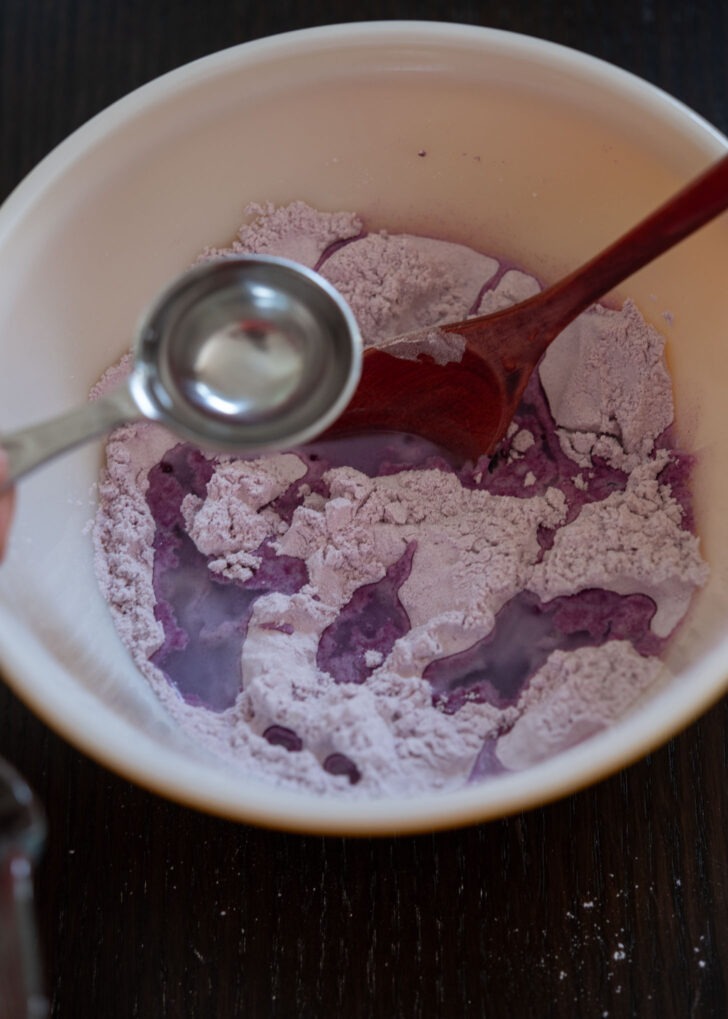
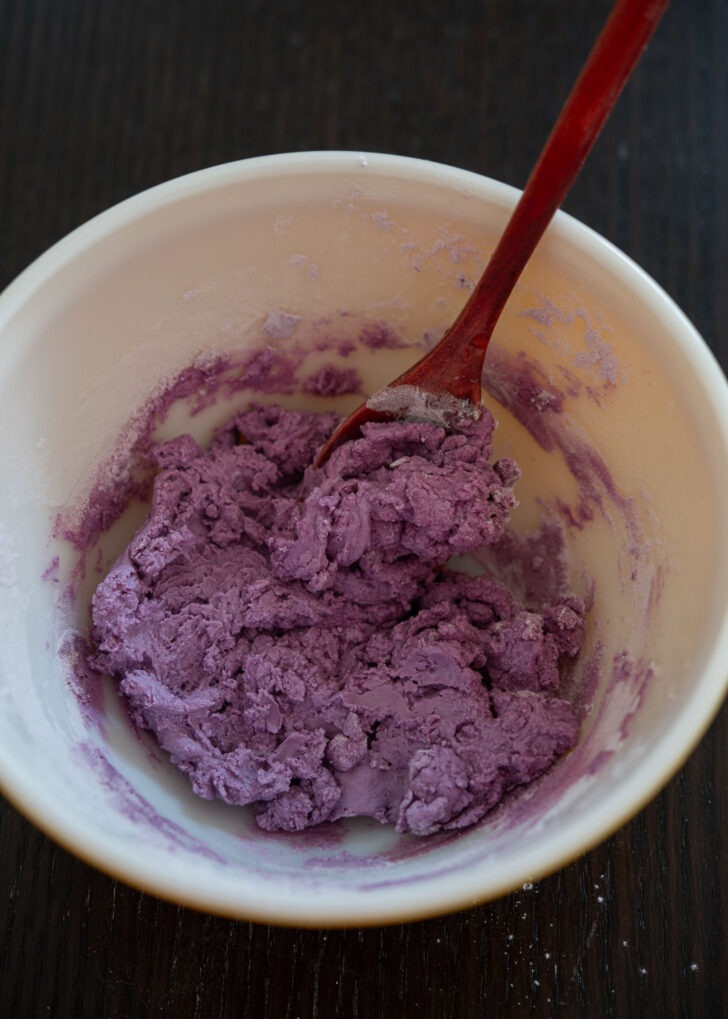
- In a mixing bowl, combine rice flour, salt, and your desired natural powder for coloring. Stir the mixture thoroughly with a spoon.
- Use dried pumpkin powder for yellow dough, mugwort powder for green dough, and so on.
- Begin by adding 2.5 tablespoons of water to the mixture. If needed, incorporate an additional little bit of water to attain the desired consistency.
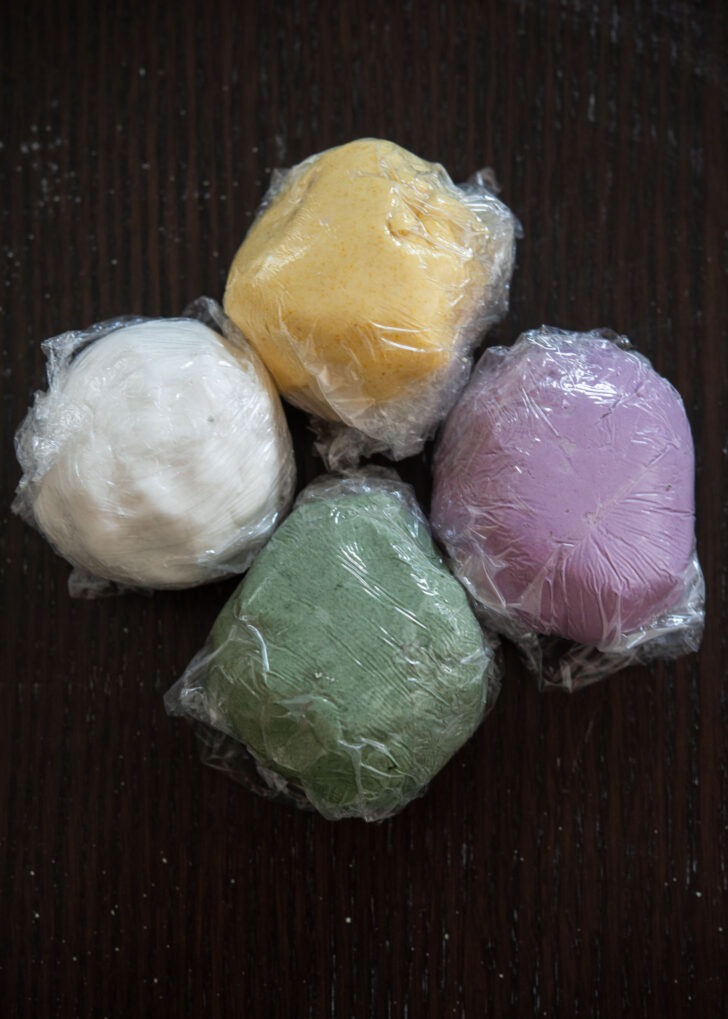
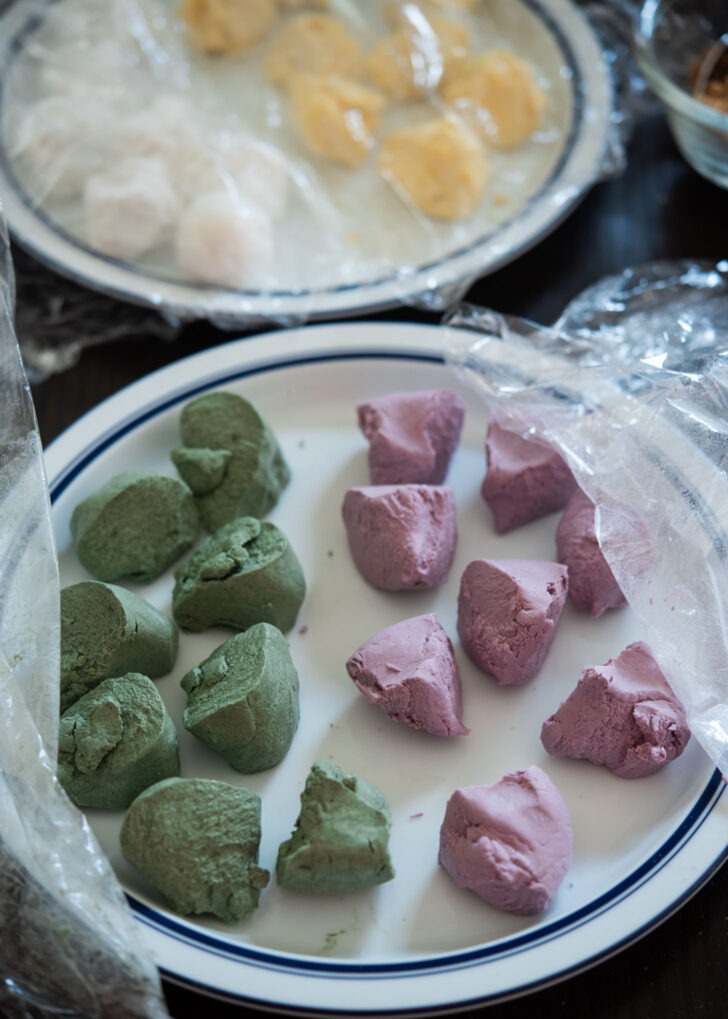
- Follow the remaining steps outlined in the white dough preparation process mentioned above.
- Cover the colored dough with plastic wrap and allow it to rest for 20-30 minutes to ensure optimal texture and handling.
Make Sweet Fillings
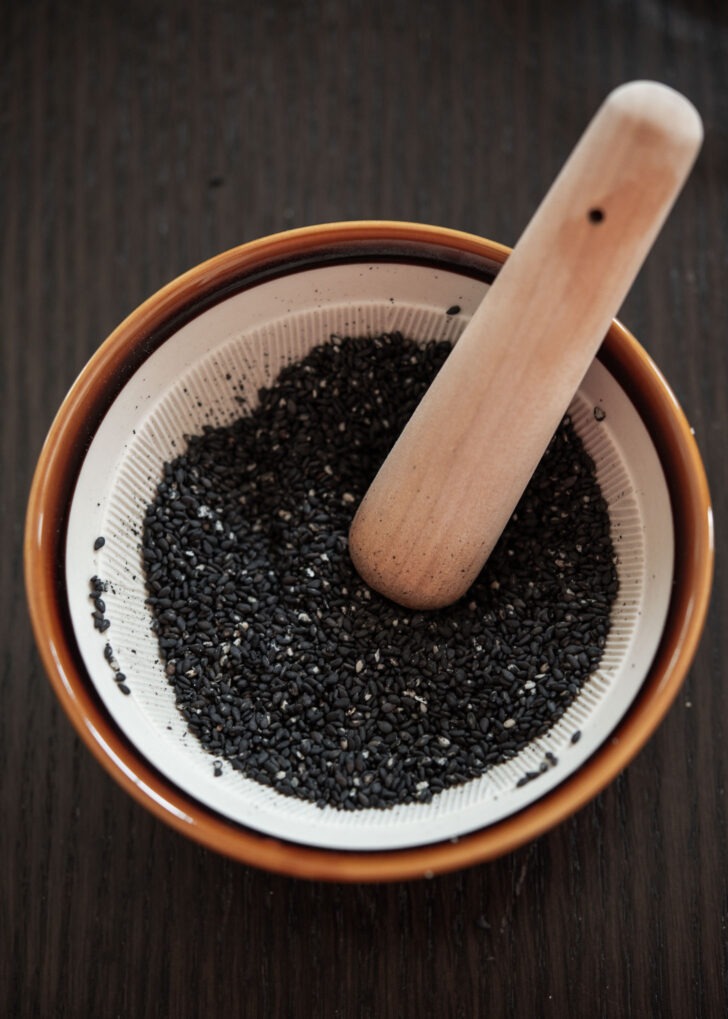
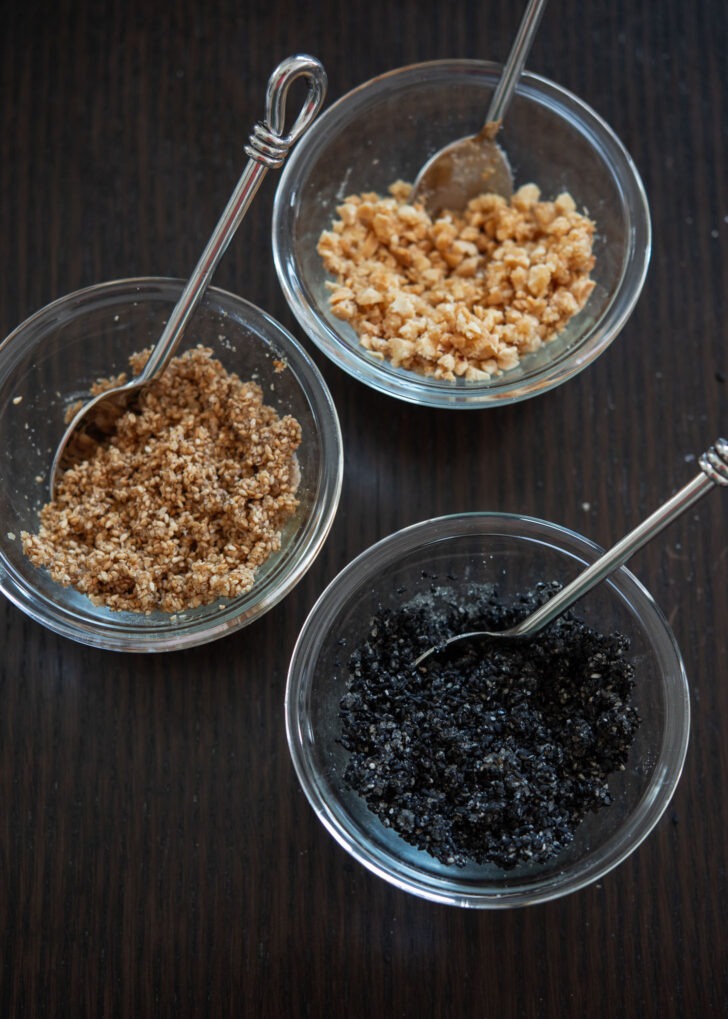
Sesame Filling:
- Take the toasted sesame seeds and roughly grind them using a suribachi or a mortar and pestle. Avoid grinding them into a fine powder.
- Transfer the coarsely ground sesame seeds to a small bowl. Add sugar and honey to the bowl.
- Mix the ingredients until the sesame seeds are thoroughly moistened and the filling is well combined.
For peanut filling:
- In a separate bowl, combine the chopped peanuts with sugar and honey.
Shaping Songpyeon Dough
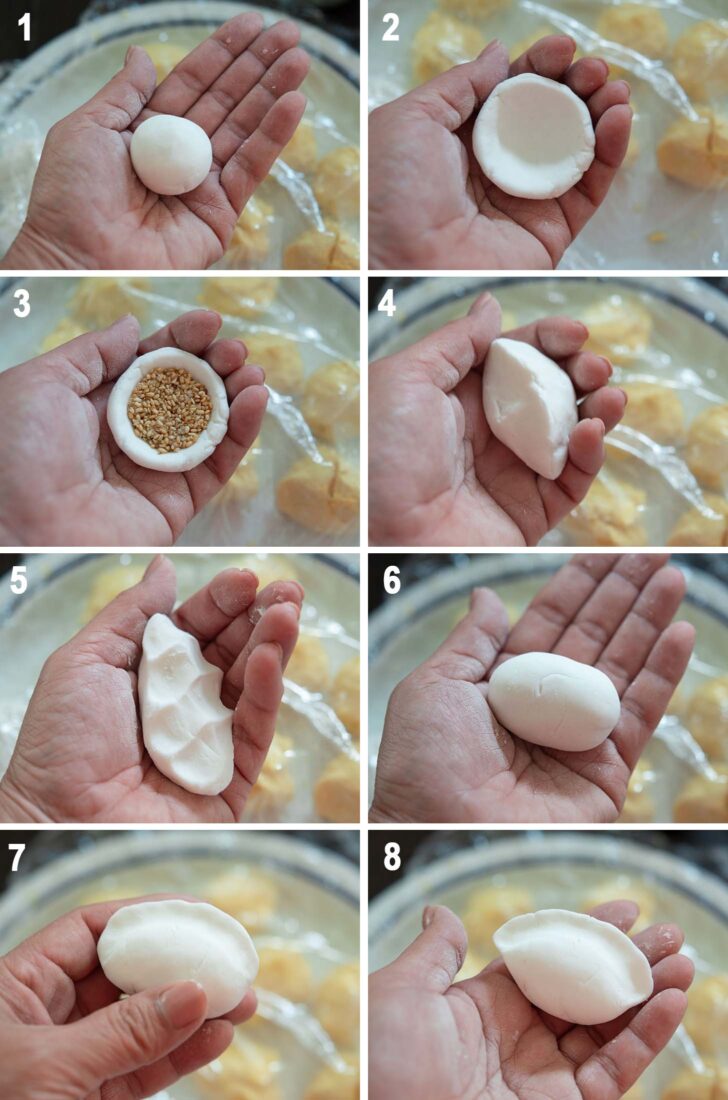
- Begin by tearing off a small piece of the dough, enough to create roughly a 1-inch ball. (Each ball weighs about 25-30g) Roll the dough tightly between your palms to form a smooth ball.
- Press your thumb into the ball to create a well in the center. Then, using both thumbs, gently push outwards on the inner walls of the well to slightly expand the opening.
- Place approximately 1 teaspoon of your chosen filling into the well.
- Seal the dough tightly by pinching the edges together.
- Lightly squeeze the entire rice cake in your palm to eliminate any trapped air. Then, gently roll it between your palms to achieve a smooth surface.
- Mold the rice cake into an oval shape.
- Lastly, pinch along the sides to create a wing-like appearance.
- Repeat these steps until you have shaped all the dough and used up the filling.
Steaming and Finishing Touch
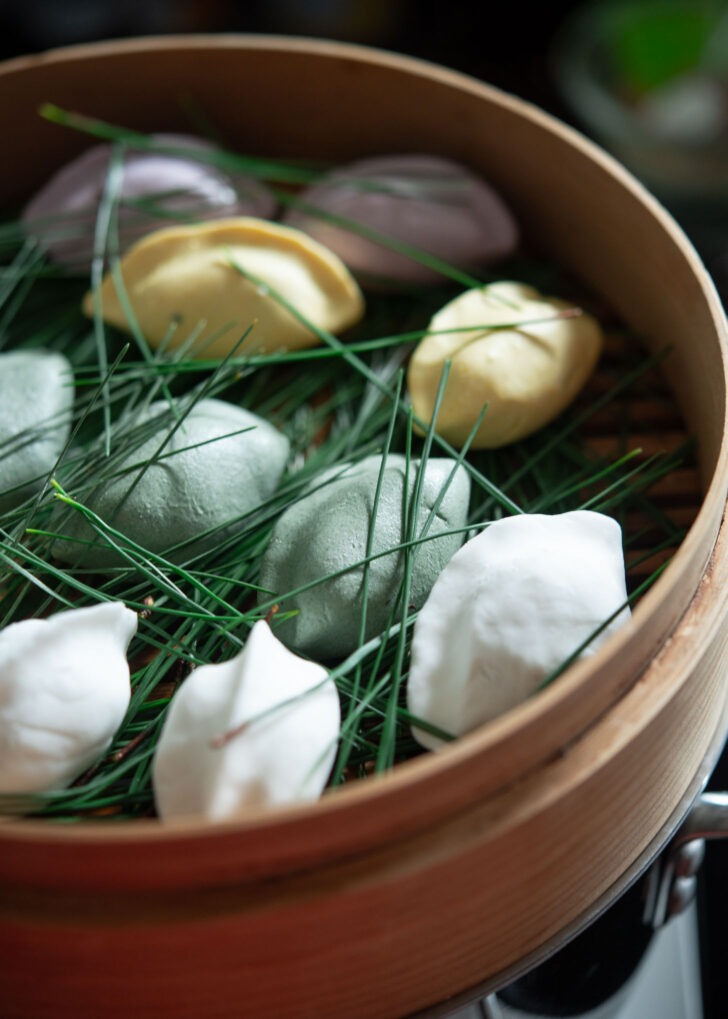
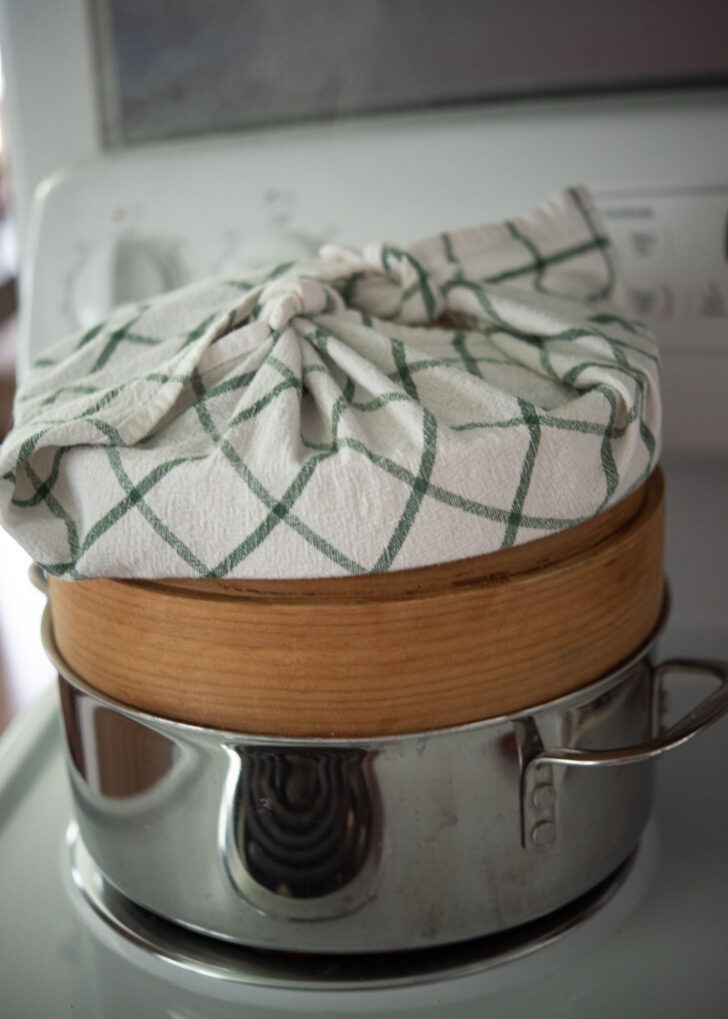
- Place a thin layer of pine needles, a silicone liner, or a damp kitchen cloth in the steamer insert to prevent sticking.
- Once the steam begins to rise, carefully arrange the rice cakes in the steamer insert, ensuring they do not touch each other.
- If you use pine needles, add a thin layer on top of the rice cakes. This adds a delightful aroma.
- Cover the steamer and steam the rice cakes for approximately 20 minutes.
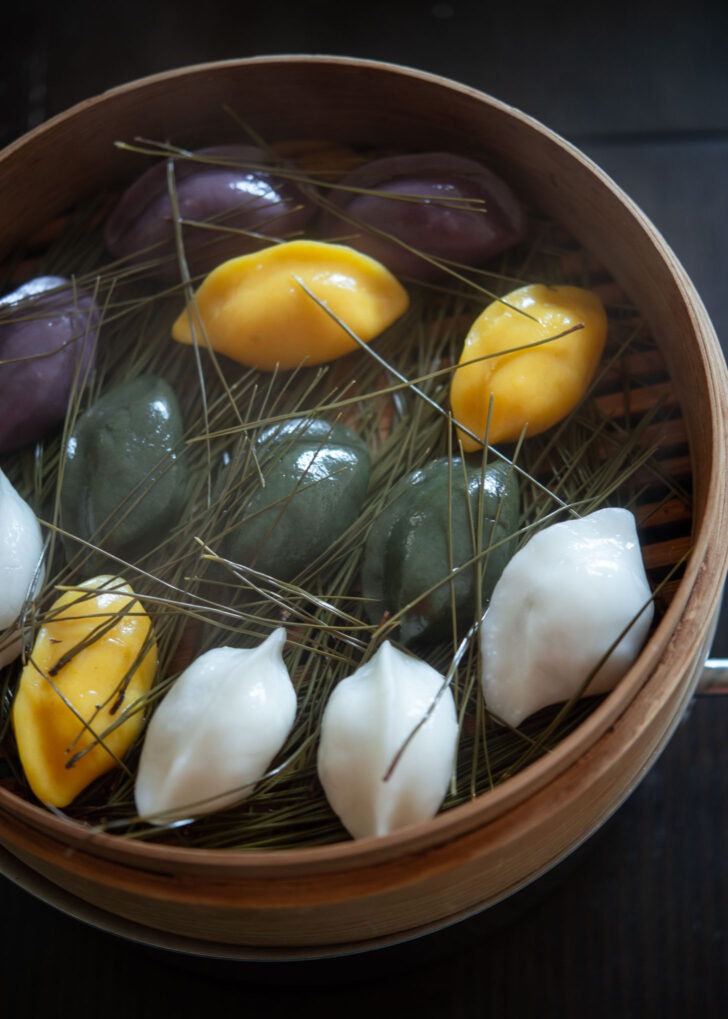
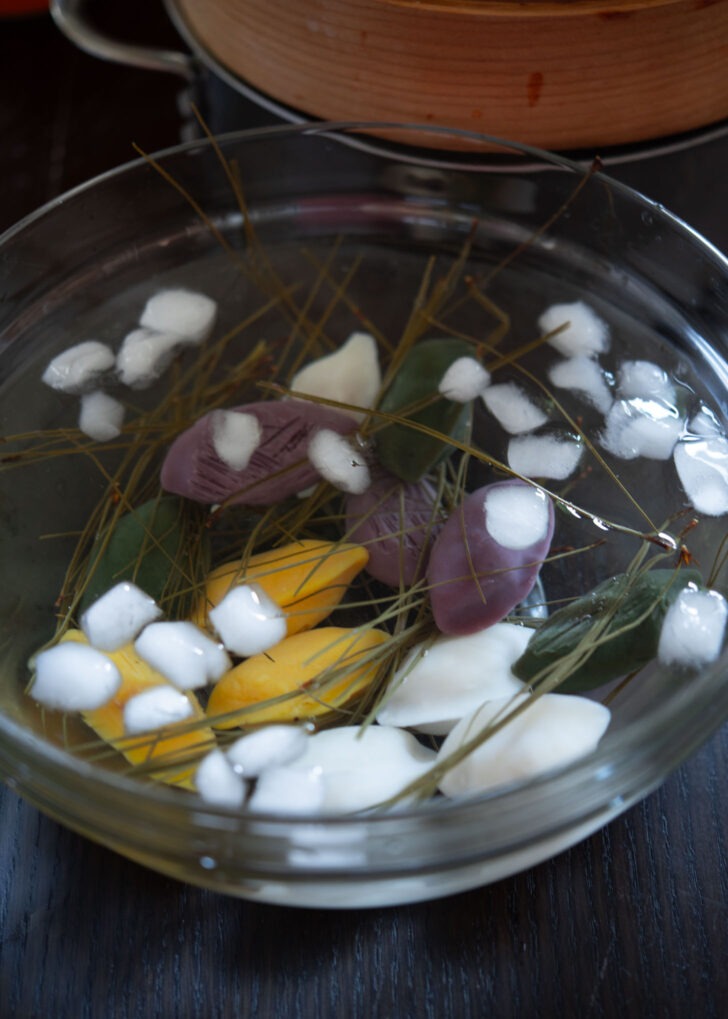
- Using a long-handled spoon or tongs, gently remove the steamed rice cakes from the steamer and place them in the ice-cold water for a quick rinse.
- Be sure to remove any pine needles if they were used.
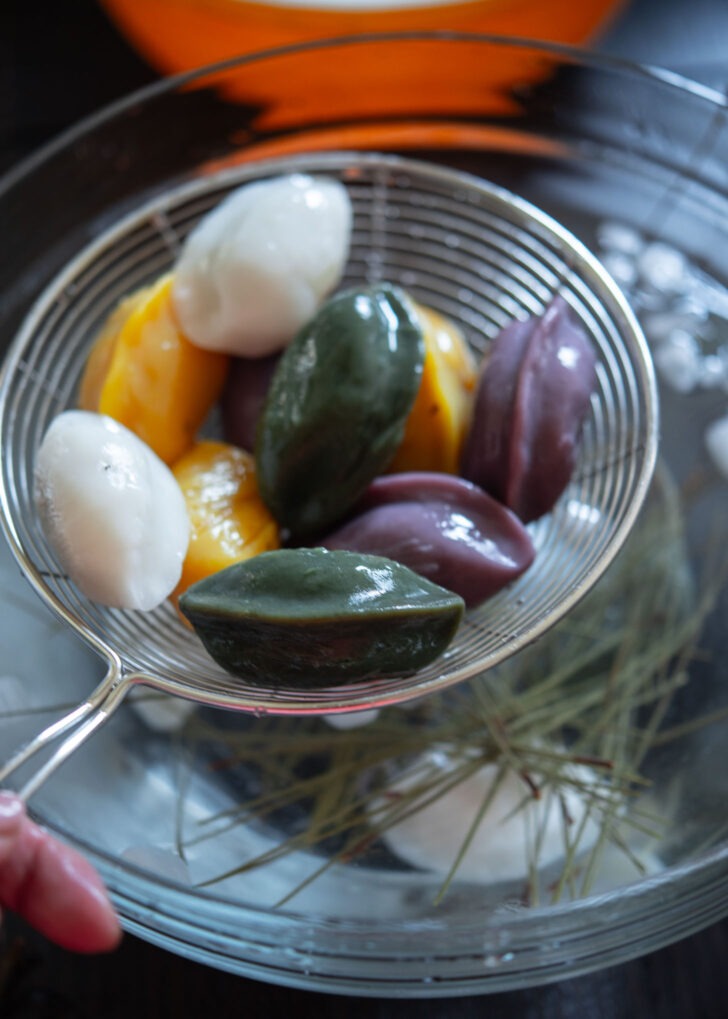
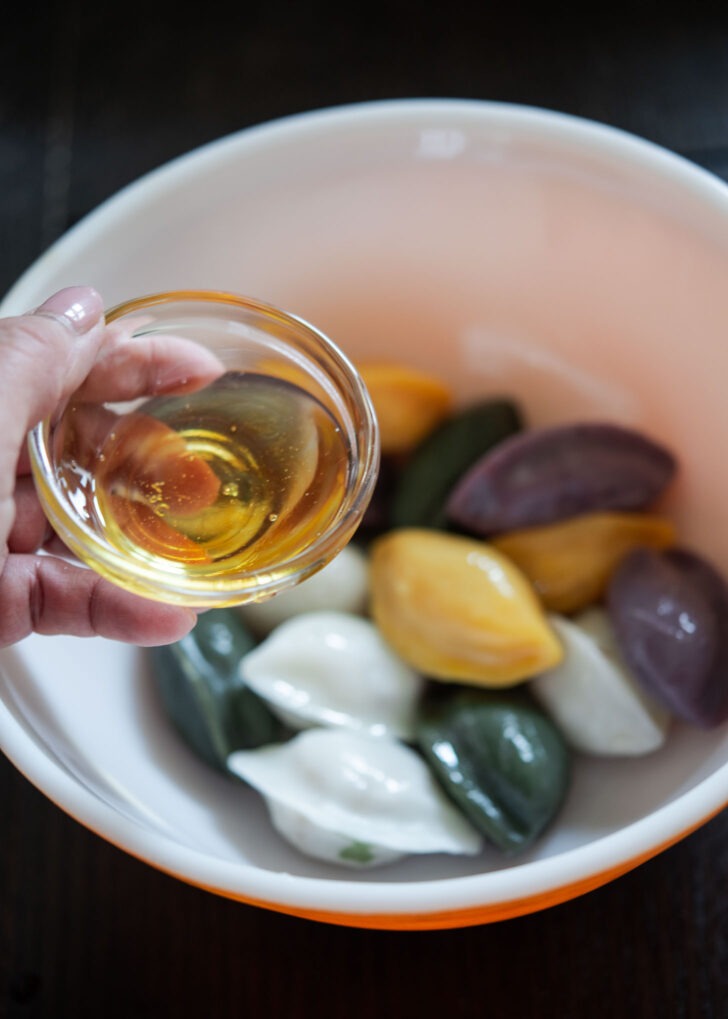
- Transfer the rice cakes to a colander to drain excess water.
- Combine sesame oil and vegetable oil, then apply this mixture to the rice cakes in batches to give them a glossy finish.
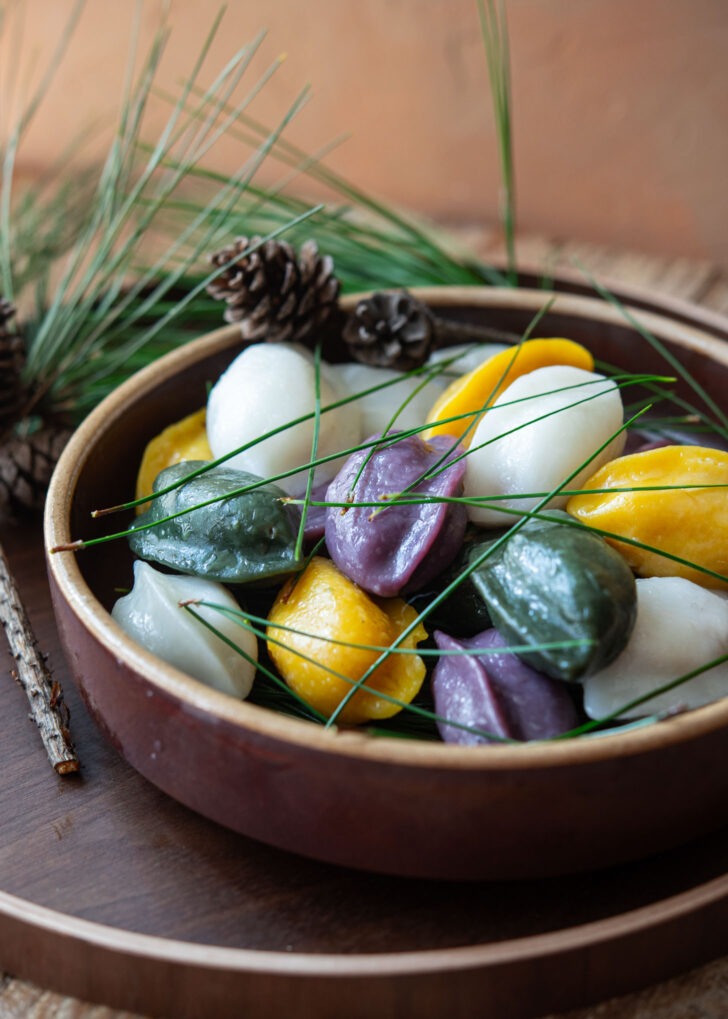
Storage and Freezing Tips
Your Songpyeon can be served warm or at room temperature. To enjoy Songpyeon beyond the holiday season, follow these storage tips:
- Store at room temperature for 1-2 days in an airtight container.
- Extend shelf life by freezing individually on a baking sheet, then store in an airtight container or freezer bag for several months. Thaw at room temperature or in the refrigerator, avoiding the microwave.
- If needed, briefly steam to restore moisture and flavor.
Related Recipes for Chuseok
Explore these popular Chuseok recipes for the special occasion or other Korean holiday:
- Injeolmi (Korean rice dessert with soybean powder)
- Yakshik (sweet rice with dried fruits and nuts)
- Shikhye (Korean rice punch)
- Wanja Jeon (Meat and tofu patties)
- Authentic Bibimbap Under 1 Hour
Love this recipe? Rate it and share your experience in the comments below! On Instagram? Tag me to showcase your creation. For more delicious recipes, subscribe to our newsletter!
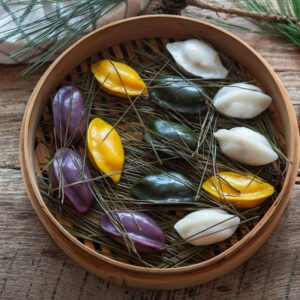
Songpyeon (Korean Chuseok Rice Cake)
Recipe Video
Ingredients
- 4 cups frozen wet rice flour, see note below
- 1/2 tsp salt
- 12 oz pine needles, soaked in water for 10 minutes, optional
- 2 tsp sesame oil
- 2 tsp vegetable oil
For basic white songpyeon dough
- 1 cup frozen wet rice flour
- 1/8 tsp salt
- 2-3 tbsp hot water, more as needed, in 1 teaspoon gradations
Other colored songpyeon (yellow, green, and purple dough)
- 1 cup frozen wet rice flour, per each batch
- 1/8 tsp salt, per each batch
- 1 tbsp pumpkin powder, mugwort powder or purple sweet potato powder, per each batch
- 2 1/2-31/2 tbsp hot water, more as needed, in 1 teaspoon gradations, per each color
Sweet filling (for sesame seeds) – fills 1 batch
- 1/4 cup toasted sesame seeds, coarsely ground
- 1 tbsp sugar
- 2 tsp honey
For other sweet filling options
- 1/4 cup black sesame seeds, or finely chopped peanuts or walnuts
- 1 tbsp sugar, per each filling
- 2 tsp honey, per each filling
Equipment
Instructions
Preparing basic songpyeon dough
- In a medium bowl, combine rice flour and salt. Begin by adding 2 tablespoons of water and stir with a spoon. If necessary, add a teaspoon or two more of water to achieve the desired consistency.
- Knead the dough by pressing and stretching it with the heel of your hand. Remember to fold and rotate the dough during this process. Continue kneading for 4 to 5 minutes.
- To adjust the dough's consistency: If the dough becomes too wet and sticks to your hands or the bowl, add more rice powder in 1 tablespoon increments.If the dough feels too dry and breaks easily, it needs more moisture. Gradually add more boiling hot water in 1 teaspoon increments.The dough should reach a texture where, when pressed with a finger, it feels similar to your earlobe.
- Cover the dough with plastic wrap and allow it to rest for 20 to 30 minutes. This resting period helps relax the dough for better handling.
For colored dough
- In a mixing bowl, combine rice flour, salt, and your desired natural powder for coloring. Use dried pumpkin powder for yellow dough, mugwort powder for green dough, and so on. Stir the mixture thoroughly with a spoon.
- Begin by adding 2.5 tablespoons of water to the mixture. If needed, incorporate an additional little bit of water to attain the desired consistency. Follow the remaining steps outlined in the white dough preparation process mentioned above. Cover the colored dough with plastic wrap and allow it to rest for 20-30 minutes to ensure optimal texture and handling.
Make Sweet Fillings
- Sesame Filling: Take the toasted sesame seeds and roughly grind them using a suribachi or a mortar and pestle. Avoid grinding them into a fine powder. Transfer the coarsely ground sesame seeds to a small bowl. Add sugar and honey to the bowl. Mix the ingredients until the sesame seeds are thoroughly moistened and the filling is well combined.
- For peanut filling: In a separate bowl, combine the chopped peanuts with sugar and honey.
Shaping Songpyeon Dough
- Begin by tearing off a small piece of the dough, enough to create roughly a 1-inch ball. (Each ball weighs about 25-30g) Roll the dough tightly between your palms to form a smooth ball.
- Press your thumb into the ball to create a well in the center. Then, using both thumbs, gently push outwards on the inner walls of the well to slightly expand the opening.
- Place approximately 1 teaspoon of your chosen filling into the well. Seal the dough tightly by pinching the edges together. Lightly squeeze the entire rice cake in your palm to eliminate any trapped air. Then, gently roll it between your palms to achieve a smooth surface.
- Mold the rice cake into an oval shape. Lastly, pinch along the sides to create a wing-like appearance. Repeat these steps until you have shaped all the dough and used up the filling.
Steaming and finishing touch
- Place a thin layer of pine needles, a silicone liner, or a damp kitchen cloth in the steamer insert to prevent sticking.
- Once the steam begins to rise, carefully arrange the rice cakes in the steamer insert, ensuring they do not touch each other. If you use pine needles, add a thin layer on top of the rice cakes. This adds a delightful aroma. Cover the steamer and steam the rice cakes for approximately 20 minutes.
- Meanwhile, prepare a large bowl filled with ice-cold water. Using a long-handled spoon or tongs, gently remove the steamed rice cakes from the steamer and place them in the cold water for a quick rinse. Be sure to remove any pine needles if they were used.
- Transfer the rice cakes to a colander to drain excess water. Combine sesame oil and vegetable oil, then apply this mixture to the rice cakes in batches to give them a glossy finish. Your Songpyeon can be served warm or at room temperature.
Notes
- Combine the flour with salt.
- Add 3 tablespoons of water and rub the rice flour between your palms to evenly distribute the moisture. Pass it through a medium sieve to sift.
- Cover the mixture with plastic wrap and allow it to rest in the fridge for a few hours or overnight. Proceed with the recipe.


Hello !
I love Songpyeon and look forward to use your recipe.
Can we use needles from any specie of pine trees or do we have to be careful which ones we choose from ?
As long as the pine tree has long needles, it should work fine.
The video is so bright and hard to see what you’re doing. I’m very interested in this recipe and a visual presentation would help me in making this yummy looking 떡.(Maybe the prob is just on my iPad?). Thx.
I’m sorry to hear that it’s difficult to see the video. Unfortunately, I can’t change the brightness after the video is imported. I recommend adjusting the brightness of your device’s monitor screen to see if that helps.
Hi Holly. I was able to watch it on my android phone. I still can’t watch it on my iPad. Weird.
Anyway, love your recipes! I especially love the simple quick yaki udon. Flavor is amazing and even my friend who’s not a big fan of cabbage (go figure😁) loved it when I made it for her a while back. Now she makes it all the time for her family. Thx for your simple to follow recipes!